Lower Cook Inlet Management Area
Fishing Opportunities
Fishing Opportunities
Saltwater Salmon Fisheries
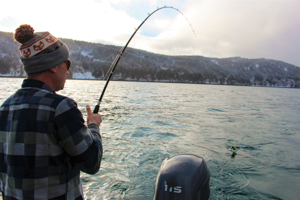 All 5 species of salmon are caught sport fishing in Kachemak Bay and Lower Cook Inlet, but king salmon are the most-caught and chum salmon are the least harvested. King salmon are caught year-round, while coho, sockeye, and pink salmon are typically caught July through September. Mid to late-July presents the best time to catch all 5 species of salmon.
All 5 species of salmon are caught sport fishing in Kachemak Bay and Lower Cook Inlet, but king salmon are the most-caught and chum salmon are the least harvested. King salmon are caught year-round, while coho, sockeye, and pink salmon are typically caught July through September. Mid to late-July presents the best time to catch all 5 species of salmon.
King Salmon Fisheries
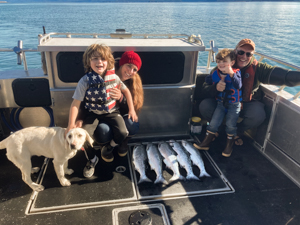 In the Lower Cook Inlet Management area, saltwater king salmon fishing occurs year-round in the nearshore waters of Kachemak Bay and east Cook Inlet. King salmon are typically targeted by trolling in boats, although it is possible to catch a king salmon from shore at the tip of the Homer Spit or from the beach near Whiskey Gulch in Cook Inlet. The sport fishery targets a mixture of Chinook salmon stocks from Alaska, British Columbia, and the West Coast of the U.S. These feeder (immature) king salmon are caught year round, while mature (spawning) king salmon make up a small portion of the harvest April through August.
In the Lower Cook Inlet Management area, saltwater king salmon fishing occurs year-round in the nearshore waters of Kachemak Bay and east Cook Inlet. King salmon are typically targeted by trolling in boats, although it is possible to catch a king salmon from shore at the tip of the Homer Spit or from the beach near Whiskey Gulch in Cook Inlet. The sport fishery targets a mixture of Chinook salmon stocks from Alaska, British Columbia, and the West Coast of the U.S. These feeder (immature) king salmon are caught year round, while mature (spawning) king salmon make up a small portion of the harvest April through August.
Feeder King Salmon
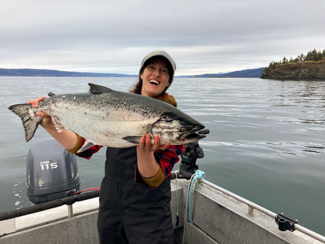 This troll fishery is primarily accessed by boat from the Homer or Seldovia harbors. The Anchor Point and Deep Creek tractor launches provide seasonal access to upper Cook Inlet. Most anglers use downriggers and troll herring or lures behind flashers in water up to 100 feet deep. Feeder king salmon are caught along the south shore of Kachemak Bay from Point Pogibshi east to Chugachik Island and the shoreline from Homer north to Anchor Point. Find details on fishing for king salmon out of Homer on this ADF&G Fishing Forum.
This troll fishery is primarily accessed by boat from the Homer or Seldovia harbors. The Anchor Point and Deep Creek tractor launches provide seasonal access to upper Cook Inlet. Most anglers use downriggers and troll herring or lures behind flashers in water up to 100 feet deep. Feeder king salmon are caught along the south shore of Kachemak Bay from Point Pogibshi east to Chugachik Island and the shoreline from Homer north to Anchor Point. Find details on fishing for king salmon out of Homer on this ADF&G Fishing Forum.
Spawner King Salmon
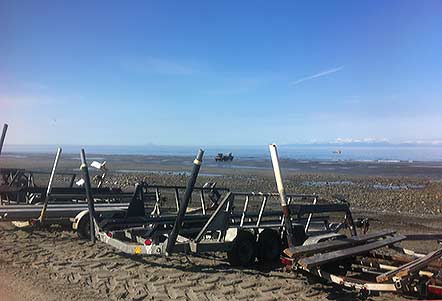 From April through August, when spawner king salmon are returning to Cook Inlet streams, anglers often target them in the Cook Inlet waters from Bluff Point north to Deep Creek. Access to the area occurs from private tractor launches at Deep Creek and Anchor Point, the Homer harbor, and some anglers launch small skiffs from the beach at Whiskey Gulch. Anglers find their best success fishing close to shore in waters less than 40 feet deep. Most anglers still use downriggers but divers or trolling sinkers are also effective. Herring or lures fished with flashers or dodgers have also proven successful. Spoons or spinners larger than ones typically used for feeder king salmon are often used to target these fish. Additional spawner king salmon are available at the two enhanced fisheries in Kachemak Bay. See the Enhanced Fisheries Tab above for more information.
From April through August, when spawner king salmon are returning to Cook Inlet streams, anglers often target them in the Cook Inlet waters from Bluff Point north to Deep Creek. Access to the area occurs from private tractor launches at Deep Creek and Anchor Point, the Homer harbor, and some anglers launch small skiffs from the beach at Whiskey Gulch. Anglers find their best success fishing close to shore in waters less than 40 feet deep. Most anglers still use downriggers but divers or trolling sinkers are also effective. Herring or lures fished with flashers or dodgers have also proven successful. Spoons or spinners larger than ones typically used for feeder king salmon are often used to target these fish. Additional spawner king salmon are available at the two enhanced fisheries in Kachemak Bay. See the Enhanced Fisheries Tab above for more information.
Coho Salmon
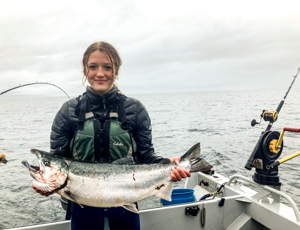 Coho salmon are targeted by trolling, very similar to how king salmon are targeted. They are typically caught during July and August, particularly at the head of Kachemak Bay near Chugachik Island, near the Homer Spit, at Silver Ridge near the mouth of Kachemak Bay, and around Point Pogibshi.
Coho salmon are targeted by trolling, very similar to how king salmon are targeted. They are typically caught during July and August, particularly at the head of Kachemak Bay near Chugachik Island, near the Homer Spit, at Silver Ridge near the mouth of Kachemak Bay, and around Point Pogibshi.
Other Salmon
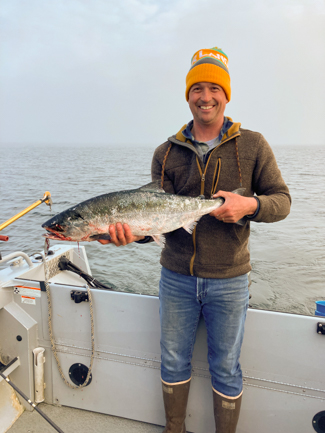 Pink salmon are commonly caught while trolling in Kachemak Bay in July and August, particularly near Point Pogibshi, Bluff Point, or on the south side of Kachemak Bay near Tutka Bay. Sockeye salmon are less commonly caught on trolling tackle, but may also be intercepted in the same locations as pink salmon. Chum salmon are also occasionally intercepted while trolling, particularly near the mouth of Kachemak Bay or Point Pogibishi. Both pink and sockeye salmon are commonly snagged on the south side of Kachemak Bay - see the Enhanced Fisheries Tab for more information. Chum salmon are rarely caught while saltwater sport fishing in Kachemak Bay and eastern Lower Cook Inlet, but you are most likely to do so while fishing near Point Pogibshi or near the mouth of Kachemak Bay.
Pink salmon are commonly caught while trolling in Kachemak Bay in July and August, particularly near Point Pogibshi, Bluff Point, or on the south side of Kachemak Bay near Tutka Bay. Sockeye salmon are less commonly caught on trolling tackle, but may also be intercepted in the same locations as pink salmon. Chum salmon are also occasionally intercepted while trolling, particularly near the mouth of Kachemak Bay or Point Pogibishi. Both pink and sockeye salmon are commonly snagged on the south side of Kachemak Bay - see the Enhanced Fisheries Tab for more information. Chum salmon are rarely caught while saltwater sport fishing in Kachemak Bay and eastern Lower Cook Inlet, but you are most likely to do so while fishing near Point Pogibshi or near the mouth of Kachemak Bay.
Enhanced Fisheries
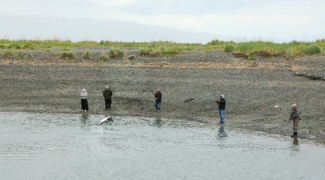 King salmon are stocked at the Nick Dudiak Fishing Lagoon on the Homer Spit and in Seldovia by ADF&G. Fishing for king salmon starts in mid-May, peaks in mid-June, and ends by July. Coho salmon are also stocked by ADF&G at the NDFL. Coho salmon fishing at the NDFL occurs from mid-July through mid-August. Cook Inlet Aquaculture Association stocks sockeye salmon in Tutka Bay Lagoon and in China Poot Lake. Those sockeye are available for snagging in saltwater beginning in late-June and lasting through July. The sockeye salmon stocked in China Poot Lake are available for dipnetting in the freshwaters of China Poot Creek as part of the China Poot personal use fishery. Pink salmon are also stocked by CIAA in Tutka Bay Lagoon and are abundant for sport fishing as they return in July. Most anglers choose to snag pink salmon there.
King salmon are stocked at the Nick Dudiak Fishing Lagoon on the Homer Spit and in Seldovia by ADF&G. Fishing for king salmon starts in mid-May, peaks in mid-June, and ends by July. Coho salmon are also stocked by ADF&G at the NDFL. Coho salmon fishing at the NDFL occurs from mid-July through mid-August. Cook Inlet Aquaculture Association stocks sockeye salmon in Tutka Bay Lagoon and in China Poot Lake. Those sockeye are available for snagging in saltwater beginning in late-June and lasting through July. The sockeye salmon stocked in China Poot Lake are available for dipnetting in the freshwaters of China Poot Creek as part of the China Poot personal use fishery. Pink salmon are also stocked by CIAA in Tutka Bay Lagoon and are abundant for sport fishing as they return in July. Most anglers choose to snag pink salmon there.
Nick Dudiak Fishing Lagoon
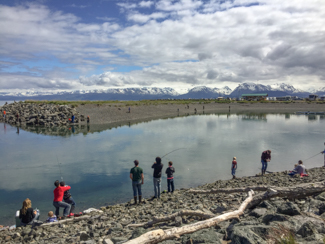 The Nick Dudiak Fishing Lagoon (AKA: The Fishing Hole) is located on the Homer Spit and has both king and coho salmon. Anglers fish the Nick Dudiak Fishing Lagoon from shore along the inside of the lagoon or just outside the entrance. The best time to fish inside of the lagoon is during an incoming tide greater than 12 feet, when the water is flowing like a river into the lagoon. Anglers tend to fish outside the lagoon during the outgoing tide, but fishing inside can be good then as well. Successful fishing techniques used include casting with lures, salmon-egg clusters, shrimp, and cut herring. Fishing eggs or herring beneath a bobber can be effective. Be sure to adjust the depth of the bait to the depth of the fish. Snagging fish in this fishery is not allowed, except by emergency order. The NDFL does not open to snagging each year, but it will if there is an excess of mature fish that have stopped biting. The potential opener for king salmon is usually around the end of June or beginning of July. The potential opener for coho salmon is typically in the first two weeks of August. Each year a youth-only fishing area is established for persons 15 years of age or younger on the first Saturday in June and first Saturday in August.
The Nick Dudiak Fishing Lagoon (AKA: The Fishing Hole) is located on the Homer Spit and has both king and coho salmon. Anglers fish the Nick Dudiak Fishing Lagoon from shore along the inside of the lagoon or just outside the entrance. The best time to fish inside of the lagoon is during an incoming tide greater than 12 feet, when the water is flowing like a river into the lagoon. Anglers tend to fish outside the lagoon during the outgoing tide, but fishing inside can be good then as well. Successful fishing techniques used include casting with lures, salmon-egg clusters, shrimp, and cut herring. Fishing eggs or herring beneath a bobber can be effective. Be sure to adjust the depth of the bait to the depth of the fish. Snagging fish in this fishery is not allowed, except by emergency order. The NDFL does not open to snagging each year, but it will if there is an excess of mature fish that have stopped biting. The potential opener for king salmon is usually around the end of June or beginning of July. The potential opener for coho salmon is typically in the first two weeks of August. Each year a youth-only fishing area is established for persons 15 years of age or younger on the first Saturday in June and first Saturday in August.
Seldovia Lagoon
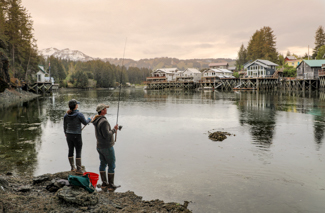 The Seldovia Lagoon is located in the small community of Seldovia and is enhanced with king salmon. Seldovia is accessed by plane, ferry, or boat. Once in Seldovia, anglers use the Slough Access road to reach the lagoon or use a small skiff from the nearby harbor. Early in the run, anglers troll near the mouth of the lagoon during high tide. Successful fishing techniques include casting with lures, salmon-egg clusters, shrimp, and cut herring. Check out the Seldovia Brochure.
The Seldovia Lagoon is located in the small community of Seldovia and is enhanced with king salmon. Seldovia is accessed by plane, ferry, or boat. Once in Seldovia, anglers use the Slough Access road to reach the lagoon or use a small skiff from the nearby harbor. Early in the run, anglers troll near the mouth of the lagoon during high tide. Successful fishing techniques include casting with lures, salmon-egg clusters, shrimp, and cut herring. Check out the Seldovia Brochure.
China Poot
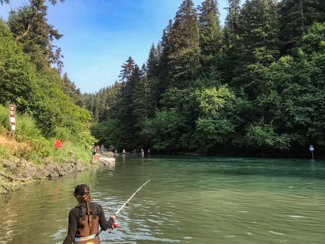 Sockeye salmon are stocked in China Poot Lake by CIAA and those that aren't harvested by the commercial salmon fishery return to China Poot Creek. Sockeye salmon begin to arrive in the salt waters of China Poot Bay in mid to late June. Most anglers choose to harvest sockeye salmon from the salt water by snagging. The fresh waters of China Poot Creek are open to dipnetting.
Sockeye salmon are stocked in China Poot Lake by CIAA and those that aren't harvested by the commercial salmon fishery return to China Poot Creek. Sockeye salmon begin to arrive in the salt waters of China Poot Bay in mid to late June. Most anglers choose to harvest sockeye salmon from the salt water by snagging. The fresh waters of China Poot Creek are open to dipnetting.
Tutka Bay Lagoon
Both pink and sockeye salmon are stocked in Tutka Bay Lagoon by CIAA and return there from mid-June through July. Many anglers enter the lagoon on high tides to snag salmon. Anglers are typically more successful at snagging sockeye salmon and avoiding pink salmon in June.
Groundfish Fisheries
Pacific Halibut
 While sport fishing for Pacific halibut may occur February 1 through December 31 annually, most sport harvest occurs between May and early September when weather conditions are more fair and when halibut can be found in shallower water. This fishery can be accessed out of the Homer or Seldovia harbors, the Whiskey Gulch beach launch, or the Anchor Point or Deep Creek tractor launches. There are numerous charter boats that operate out of Homer, Anchor Point and Deep Creek. There is no ramp available at Whiskey Gulch, so most anglers launch small boats near high tide at this location.
While sport fishing for Pacific halibut may occur February 1 through December 31 annually, most sport harvest occurs between May and early September when weather conditions are more fair and when halibut can be found in shallower water. This fishery can be accessed out of the Homer or Seldovia harbors, the Whiskey Gulch beach launch, or the Anchor Point or Deep Creek tractor launches. There are numerous charter boats that operate out of Homer, Anchor Point and Deep Creek. There is no ramp available at Whiskey Gulch, so most anglers launch small boats near high tide at this location.
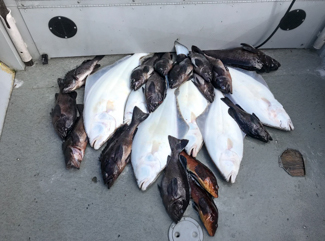 Homer is the self-proclaimed halibut capital of the world, and more sport-caught halibut have traditionally been landed in the Lower Cook Inlet ports of Homer, Anchor Point and Deep Creek/Ninilchik, than the remainder of Southcentral Alaska combined. Look for fish concentrations at depths of 50 to 200 feet, near underwater structures such as drop-offs, pinnacles, and kelp beds. Many popular spots are in the open waters of Cook Inlet, but there are some more protected spots to fish behind the Homer Spit, near Glacier Spit, Tutka Bay, and near Yukon Island. Herring is easily the most popular bait, but octopus, squid, salmon heads, weighted jigs, and combinations of these items work well. Since larger halibut (50 - 300 lbs) are common, use a stout rod loaded with 80- to 100-pound test line. Strong currents may require heavier weights (16 to 48 oz) to keep the bait on the bottom during tidal ebbs and flows so many anglers choose to fish during slack tide in order to use lighter weights. It can be effective to drift or to anchor up while fishing for halibut. Some anglers choose to use chum bags to attract fish to the area. Learn more about halibut.
Homer is the self-proclaimed halibut capital of the world, and more sport-caught halibut have traditionally been landed in the Lower Cook Inlet ports of Homer, Anchor Point and Deep Creek/Ninilchik, than the remainder of Southcentral Alaska combined. Look for fish concentrations at depths of 50 to 200 feet, near underwater structures such as drop-offs, pinnacles, and kelp beds. Many popular spots are in the open waters of Cook Inlet, but there are some more protected spots to fish behind the Homer Spit, near Glacier Spit, Tutka Bay, and near Yukon Island. Herring is easily the most popular bait, but octopus, squid, salmon heads, weighted jigs, and combinations of these items work well. Since larger halibut (50 - 300 lbs) are common, use a stout rod loaded with 80- to 100-pound test line. Strong currents may require heavier weights (16 to 48 oz) to keep the bait on the bottom during tidal ebbs and flows so many anglers choose to fish during slack tide in order to use lighter weights. It can be effective to drift or to anchor up while fishing for halibut. Some anglers choose to use chum bags to attract fish to the area. Learn more about halibut.
Lingcod and Rockfish
The lingcod fishery occurs primarily along the outer coast around the Chugach Islands and around the Barren Islands, accessible through the Homer Harbor, or the Anchor Point or Deep Creek tractor launch. Harvest of Lingcod is restricted to fish 35 inches or longer. These adult lingcod can be found near steep rocky banks or over rocky structure by anglers jigging for halibut. Most anglers drift over rockpiles or along structure with baited and unbaited lead head jigs. White grub tails are the classic lure. Learn more about lingcod.
Rockfish
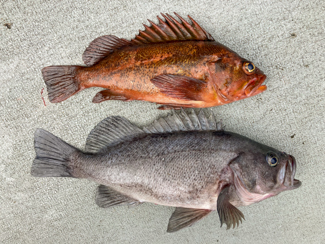 Rockfish are often caught along the outer coast while lingcod fishing, jigging for halibut, or while trolling for king salmon in Cook Inlet around kelp beds west of Seldovia or near Bluff Point. Trolling with spoons or jigging can be particularly effective at catching rockfish. Be aware of bag and possession limits which differ for the pelagic and non-pelagic varieties. If you release a rockfish, you are required to use a deepwater release mechanism to assist them with returning to the depth they were caught at. Get more information on rockfish and deepwater release devices.
Rockfish are often caught along the outer coast while lingcod fishing, jigging for halibut, or while trolling for king salmon in Cook Inlet around kelp beds west of Seldovia or near Bluff Point. Trolling with spoons or jigging can be particularly effective at catching rockfish. Be aware of bag and possession limits which differ for the pelagic and non-pelagic varieties. If you release a rockfish, you are required to use a deepwater release mechanism to assist them with returning to the depth they were caught at. Get more information on rockfish and deepwater release devices.
Other species (Pacific Cod, Kelp Greenling, Pollock)
Other groundfish species, such as Pacific Cod, kelp greenling, and pollock may be caught while fishing for other species, but they are not typically targeted or particularly common to catch for sport anglers in the Lower Cook Inlet area.
Shellfish Fisheries
Tanner Crab
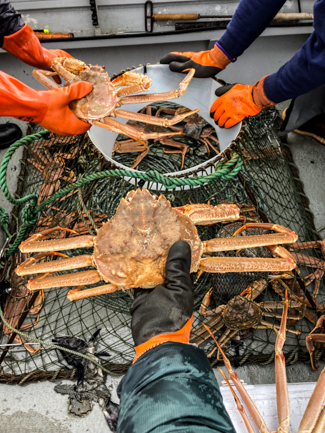 The length of the Tanner crab season, the bag and annual limit, and the number of pots allowed is determined each year based on results from the Kachemak Bay trawl survey. Look for an announcement of the fishery in August or September here. A permit is required to participate in the fishery. You can obtain a Cook Inlet North Gulf Coast Tanner Crab Sport permit at the online store.
The length of the Tanner crab season, the bag and annual limit, and the number of pots allowed is determined each year based on results from the Kachemak Bay trawl survey. Look for an announcement of the fishery in August or September here. A permit is required to participate in the fishery. You can obtain a Cook Inlet North Gulf Coast Tanner Crab Sport permit at the online store.
Tanner crab live on the seafloor down to about 1,500 feet and anglers use pots to capture them. Most anglers lower a heavily baited crab pot down into 300-500 feet of water. Some anglers set their pot over night and others set their pot at the start of the day before going out fishing and retrieve the pot when returning. Pots are baited with stinky bait such as herring and fish carcasses. To avoid tangling gear, be careful to avoid setting pots around others, which should be marked by a buoy. Harvest of Tanner crab is restricted to males whose carapace width is 4.5" or longer from side to side.
Watch the Fishing Forum on Kachemak Bay Tanner crab to learn everything you need to know to go set a pot. Online Fishing Forum: Tanner Crab Fishing in Kachemak Bay - YouTube
Razor Clams
East Cook Inlet
(from the mouth of the Kenai River to the tip of the Homer Spit)
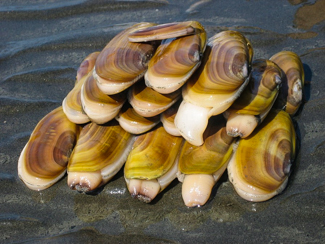 Currently closed to all clamming by Emergency Order. The fishery may open if abundance thresholds are met. For more information on the closure and how the razor clam populations are doing now see: Online Fishing Forum: What's Going on With East Cook Inlet Razor Clams? - YouTube
Currently closed to all clamming by Emergency Order. The fishery may open if abundance thresholds are met. For more information on the closure and how the razor clam populations are doing now see: Online Fishing Forum: What's Going on With East Cook Inlet Razor Clams? - YouTube
West Cook Inlet
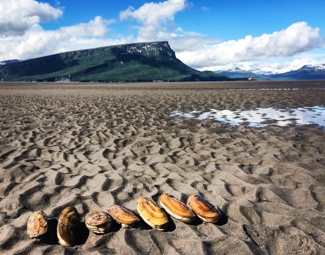 Razor clams are primarily harvested by sport diggers in West Cook Inlet on the Polly Creek and Crescent River Bar beaches, but digging also occurs at Silver Salmon beach, and Clam Cove in Chinitna Bay. These beaches are accessed by boat most commonly from the Deep Creek tractor launch, but also from the Anchor Point tractor launch, the Kenai River dock, and the Homer Harbor. Many charters run out of the Deep Creek tractor launch to take diggers across. Only boats seaworthy of crossing Cook Inlet should make the trip. The beaches are also accessible by small wheel plane. Clams are harvested by using a clam shovel or clam gun after locating a "show", or dimple in the sand.
Razor clams are primarily harvested by sport diggers in West Cook Inlet on the Polly Creek and Crescent River Bar beaches, but digging also occurs at Silver Salmon beach, and Clam Cove in Chinitna Bay. These beaches are accessed by boat most commonly from the Deep Creek tractor launch, but also from the Anchor Point tractor launch, the Kenai River dock, and the Homer Harbor. Many charters run out of the Deep Creek tractor launch to take diggers across. Only boats seaworthy of crossing Cook Inlet should make the trip. The beaches are also accessible by small wheel plane. Clams are harvested by using a clam shovel or clam gun after locating a "show", or dimple in the sand.
Other Shellfish
There is no bag limit for other shellfish. This includes other species of clams such as mussels, octopus, other clams such as cockles and surf clams, and limpits.
Mussels
These are easily found in the rocky intertidal on the south side of Kachemak Bay. Keep them alive in salt water until you cook them for consumption.
Hardshell Clams
Hardshell clams are closed to sport harvest in Kachemak Bay, Cook Inlet, and the North Gulf Coast.
Roadside Freshwater Fisheries
Lower Kenai Peninsula Roadside Streams
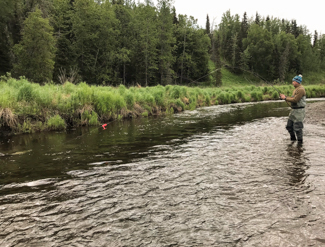 In the Lower Cook Inlet management area, opportunities to fish for salmon and trout are found in four road accessible streams (Ninilchik and Anchor rivers, Deep and Stariski creeks). These streams are small coastal streams that feed into Cook Inlet. Sport fishing for king and coho salmon, steelhead and Dolly Varden are the most popular. The Ninilchik River and Deep Creek are located in the town of Ninilchik; Stariski Creek and the Anchor River are located near Anchor Point. The Sterling Highway provides access to all four streams. Salmon fishing is only allowed in these streams from the mouth upstream approximately two miles and Stariski Creek is closed to king salmon fishing. Fishing for steelhead trout and Dolly Varden upstream of the two-mile marker is allowed from August 1 through October 31. Anchor, Deep, and Ninilchik are closed November 1 until the first weekend open to king salmon fishing in late-May. Ninilchik River opens continuously for hatchery king salmon fishing on June 16.
In the Lower Cook Inlet management area, opportunities to fish for salmon and trout are found in four road accessible streams (Ninilchik and Anchor rivers, Deep and Stariski creeks). These streams are small coastal streams that feed into Cook Inlet. Sport fishing for king and coho salmon, steelhead and Dolly Varden are the most popular. The Ninilchik River and Deep Creek are located in the town of Ninilchik; Stariski Creek and the Anchor River are located near Anchor Point. The Sterling Highway provides access to all four streams. Salmon fishing is only allowed in these streams from the mouth upstream approximately two miles and Stariski Creek is closed to king salmon fishing. Fishing for steelhead trout and Dolly Varden upstream of the two-mile marker is allowed from August 1 through October 31. Anchor, Deep, and Ninilchik are closed November 1 until the first weekend open to king salmon fishing in late-May. Ninilchik River opens continuously for hatchery king salmon fishing on June 16.
Anglers are reminded that when fishing in these streams there are several regulations prohibiting anglers from removing a fish from the water if you intend to release it. Steelhead, king salmon greater than 20", and coho salmon greater than 16" may never be removed from the water prior to release. Learn more about the Lower Kenai Peninsula Roadside Streams.
King Salmon
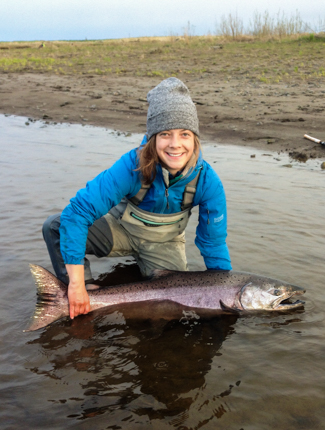 King salmon fishing occurs in late May and throughout June. Consult the sport fishing regulation summary and look for emergency orders for days in which the Lower Cook Inlet management area streams are open for fishing. Typically, the Ninilchik fishes better earlier in the season than Deep Creek and the Anchor River. Of these streams, the Anchor River has the largest run of king salmon. The Ninilchik River is also supplemented with hatchery king salmon and provides additional sport fishing opportunities. Best fishing occurs in the early morning hours or at the mouth during the incoming tide. The king salmon in these streams can be fairly aggressive and successful anglers use a variety of bait and gear to catch their king salmon. Salmon roe clusters drifted along the bottom is typically the most effective, but a variety of tackle can work very well when the fishery is restricted to single-hook no bait, including marabou jig and bobber, spinners, and plugs. Fly fishing gear is also popular and can be effective with chartreuse or pink flies. At times, steelhead heading back out to the ocean in the spring may be caught by anglers targeting king salmon. Remember to your best catch and release techniques with these tired fish.
King salmon fishing occurs in late May and throughout June. Consult the sport fishing regulation summary and look for emergency orders for days in which the Lower Cook Inlet management area streams are open for fishing. Typically, the Ninilchik fishes better earlier in the season than Deep Creek and the Anchor River. Of these streams, the Anchor River has the largest run of king salmon. The Ninilchik River is also supplemented with hatchery king salmon and provides additional sport fishing opportunities. Best fishing occurs in the early morning hours or at the mouth during the incoming tide. The king salmon in these streams can be fairly aggressive and successful anglers use a variety of bait and gear to catch their king salmon. Salmon roe clusters drifted along the bottom is typically the most effective, but a variety of tackle can work very well when the fishery is restricted to single-hook no bait, including marabou jig and bobber, spinners, and plugs. Fly fishing gear is also popular and can be effective with chartreuse or pink flies. At times, steelhead heading back out to the ocean in the spring may be caught by anglers targeting king salmon. Remember to your best catch and release techniques with these tired fish.
Silver Salmon
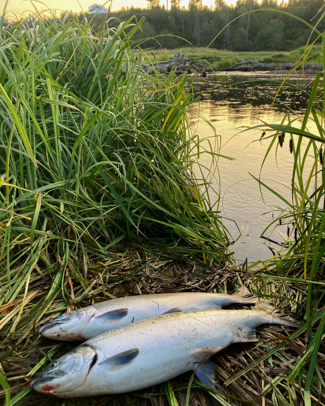 Silver salmon start entering Lower Cook Inlet streams in early August and peak in late August or early September. Large numbers of silver salmon often push upstream when flows increase from rain. Similar to king salmon fishing, the best fishing occurs in the early morning hours or at the mouth on the incoming tide. Many anglers target silvers in the intertidal portion of these streams, especially just as the tide begins to recede from the area. Bait such as salmon roe or small troll herring drifted along the bottom are the most effective. Anglers may encounter steelhead entering the streams during this time, please remember to use good catch and release practices on those fish.
Silver salmon start entering Lower Cook Inlet streams in early August and peak in late August or early September. Large numbers of silver salmon often push upstream when flows increase from rain. Similar to king salmon fishing, the best fishing occurs in the early morning hours or at the mouth on the incoming tide. Many anglers target silvers in the intertidal portion of these streams, especially just as the tide begins to recede from the area. Bait such as salmon roe or small troll herring drifted along the bottom are the most effective. Anglers may encounter steelhead entering the streams during this time, please remember to use good catch and release practices on those fish.
Steelhead
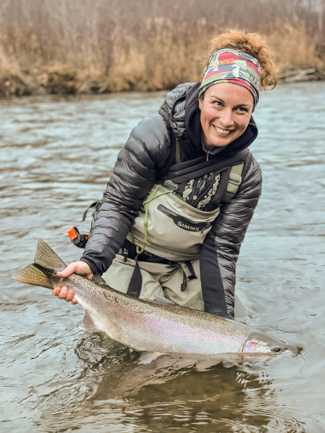 The roadside streams provide a unique opportunity to fish for steelhead in September and October. Steelhead begin entering these streams in August and run timing peaks in late September. Fishing can be good all the way to the close of the season, though fall rains can periodically make the river unfishable due to the turbidity. The Anchor River is the most popular and has multiple access locations for the section along the Sterling Highway. Most anglers fly fish by drifting egg patterns or swinging streamers, though spinners, plugs, yarn, and jig and bobbers are effective too. Steelhead fishing is catch and release only; all steelhead trout may not be removed from the water and must be released unharmed. Steelhead counts for the Anchor River are now available in some falls through September. Learn more about steelhead trout (PDF 40 kB).
The roadside streams provide a unique opportunity to fish for steelhead in September and October. Steelhead begin entering these streams in August and run timing peaks in late September. Fishing can be good all the way to the close of the season, though fall rains can periodically make the river unfishable due to the turbidity. The Anchor River is the most popular and has multiple access locations for the section along the Sterling Highway. Most anglers fly fish by drifting egg patterns or swinging streamers, though spinners, plugs, yarn, and jig and bobbers are effective too. Steelhead fishing is catch and release only; all steelhead trout may not be removed from the water and must be released unharmed. Steelhead counts for the Anchor River are now available in some falls through September. Learn more about steelhead trout (PDF 40 kB).
Dolly Varden
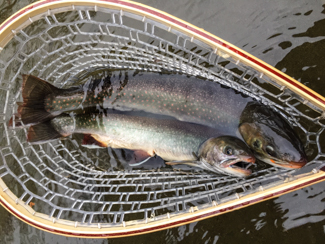 Dolly Varden fishing in the Lower Cook Inlet management area streams starts in July with good fishing in the lower stream sections in late July. Fishing for Dolly Varden upstream in upper stream sections above the two-mile stream markers can be good from the opening in August through October when it closes. Anglers targeting steelhead commonly catch Dolly Varden. Fly and spinning tackle are both effective at catching dollies. Fly anglers use a variety of fly patterns including egg imitations, smolt patterns, and small streamers. Spinners and small spoons will also catch plenty of Dolly Varden in these streams. Dolly Varden fish counts for the Anchor river are now available on the Fish Counts website. Learn more about Dolly Varden (PDF 99 kB).
Dolly Varden fishing in the Lower Cook Inlet management area streams starts in July with good fishing in the lower stream sections in late July. Fishing for Dolly Varden upstream in upper stream sections above the two-mile stream markers can be good from the opening in August through October when it closes. Anglers targeting steelhead commonly catch Dolly Varden. Fly and spinning tackle are both effective at catching dollies. Fly anglers use a variety of fly patterns including egg imitations, smolt patterns, and small streamers. Spinners and small spoons will also catch plenty of Dolly Varden in these streams. Dolly Varden fish counts for the Anchor river are now available on the Fish Counts website. Learn more about Dolly Varden (PDF 99 kB).
Other Salmon
Besides king and silver salmon, the Lower Cook Inlet management area streams will have a small run of pink salmon and a few sockeye and chum salmon. Pink salmon start entering these streams in early to mid-July and can be caught on small to medium sized spinners, spoons, and flies. Sockeye and chum salmon are sometimes caught while fishing for Dolly Varden or pink salmon but are rarely targeted in these streams. Learn more about pink salmon, chum salmon, and sockeye salmon. Learn more about pink salmon, chum salmon, and sockeye salmon.
